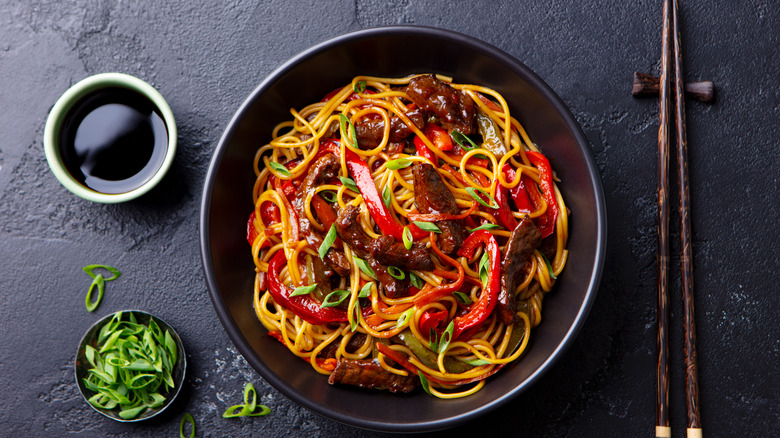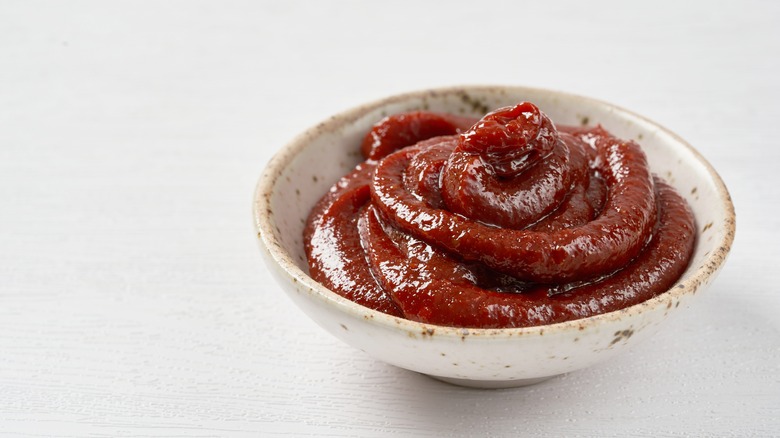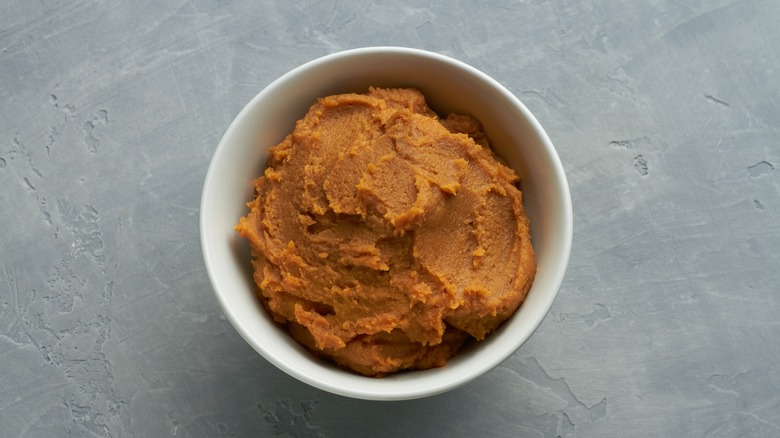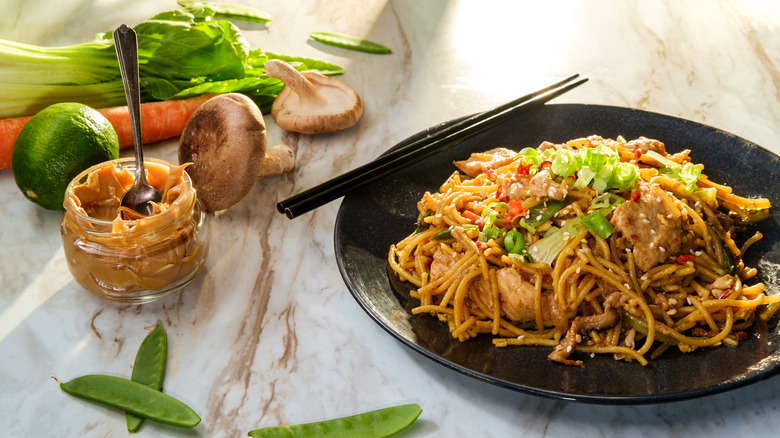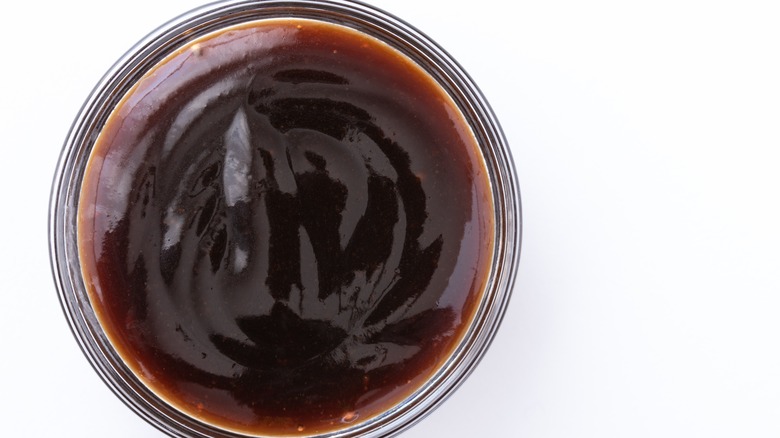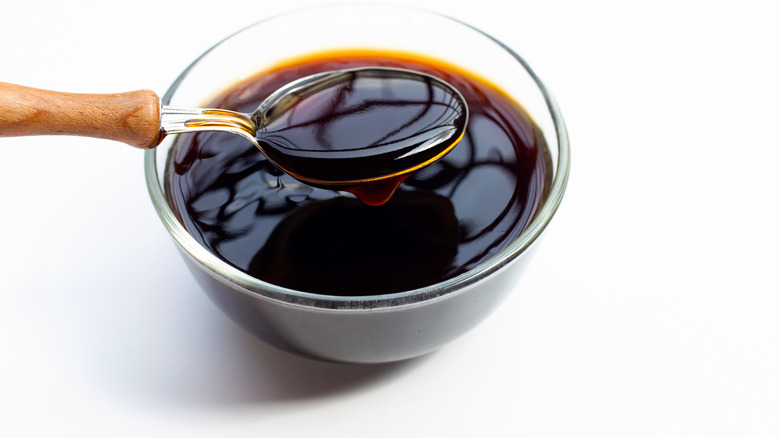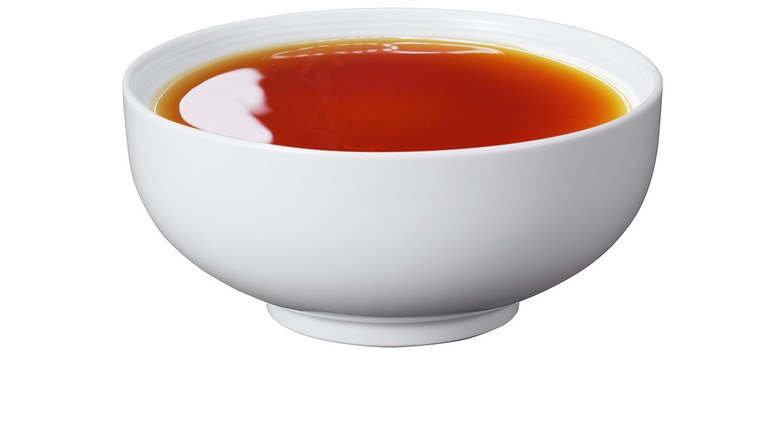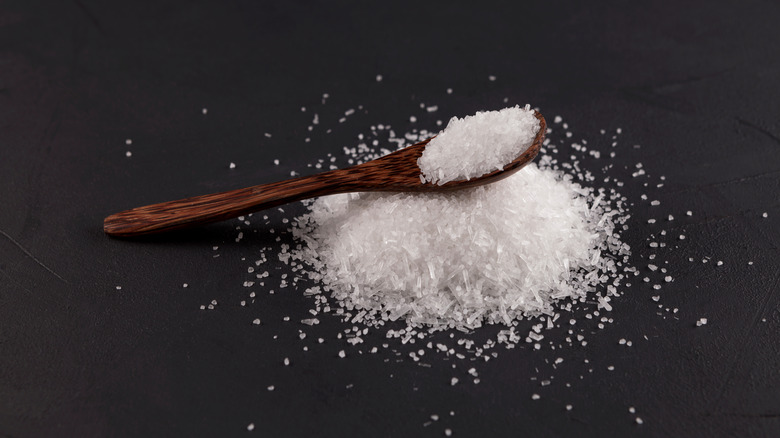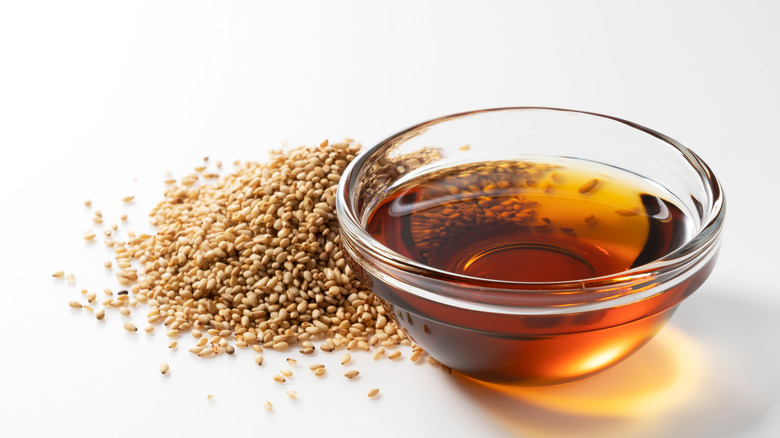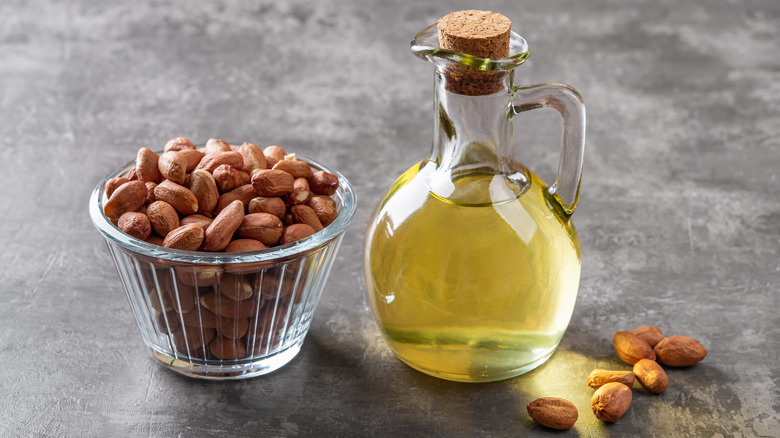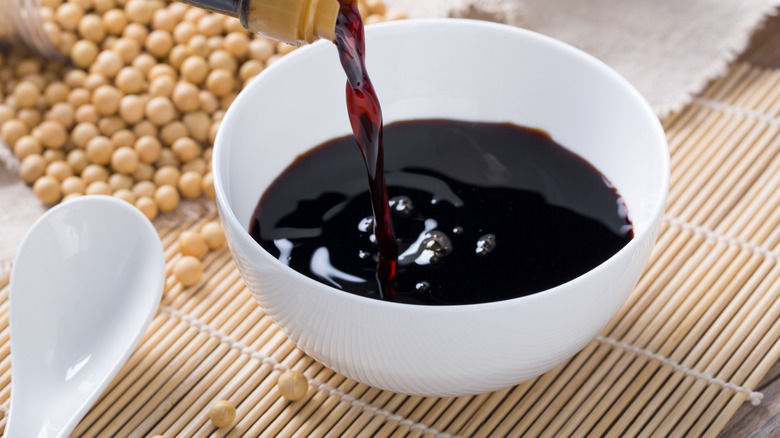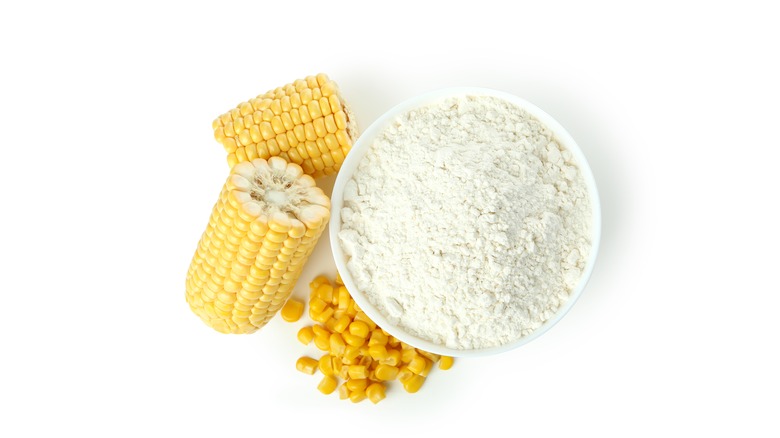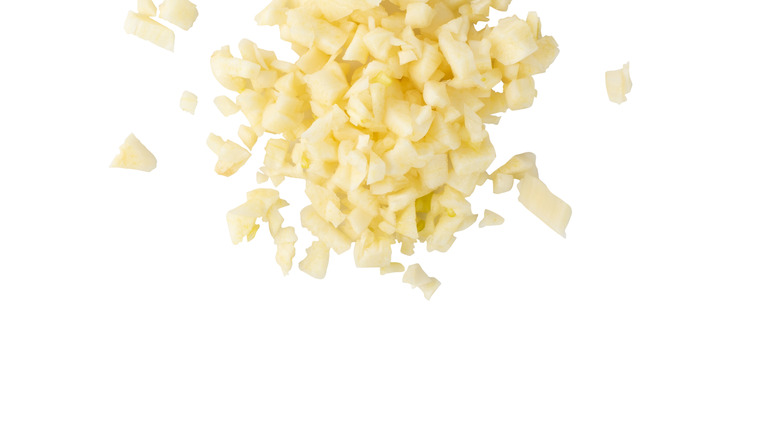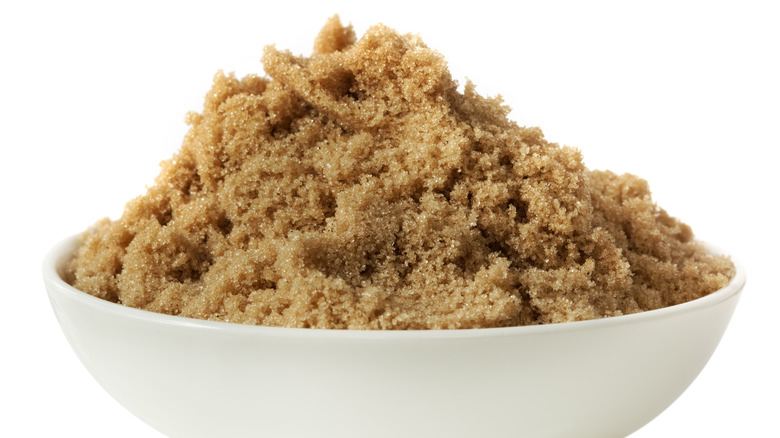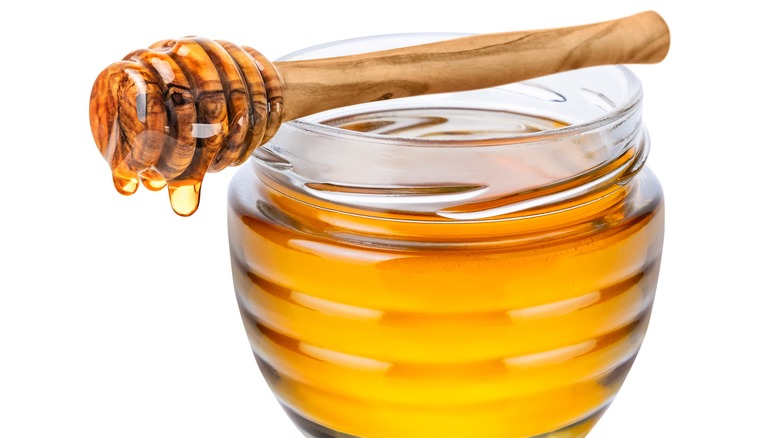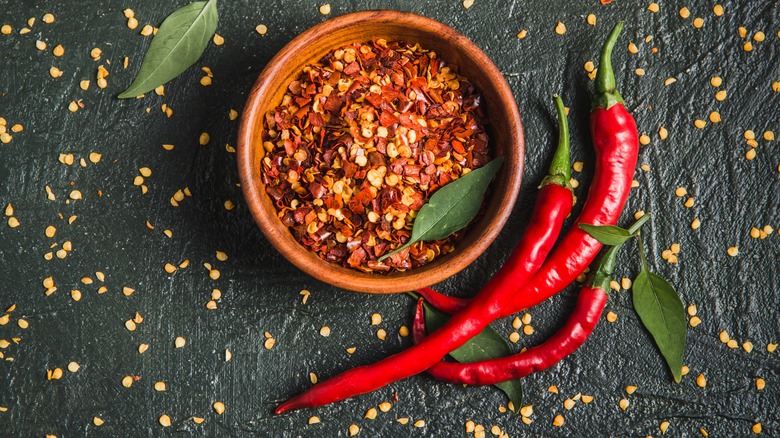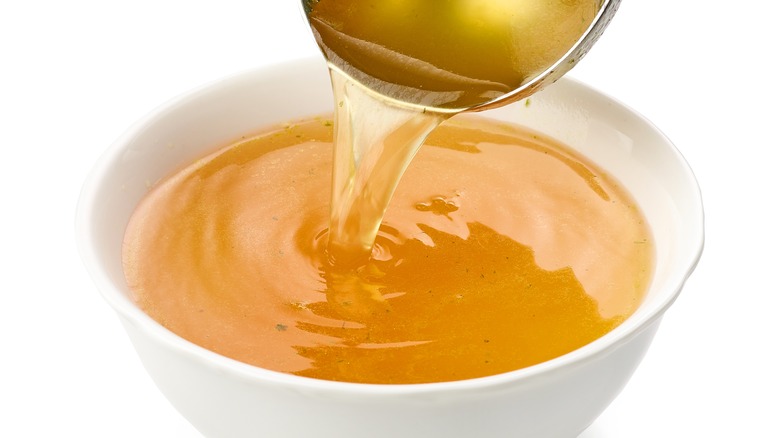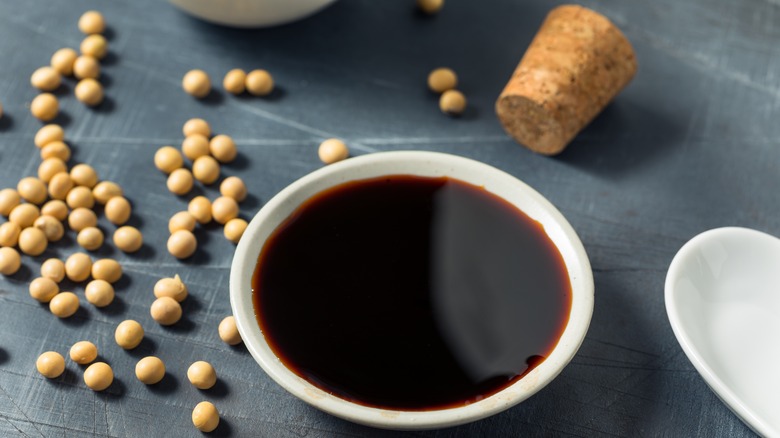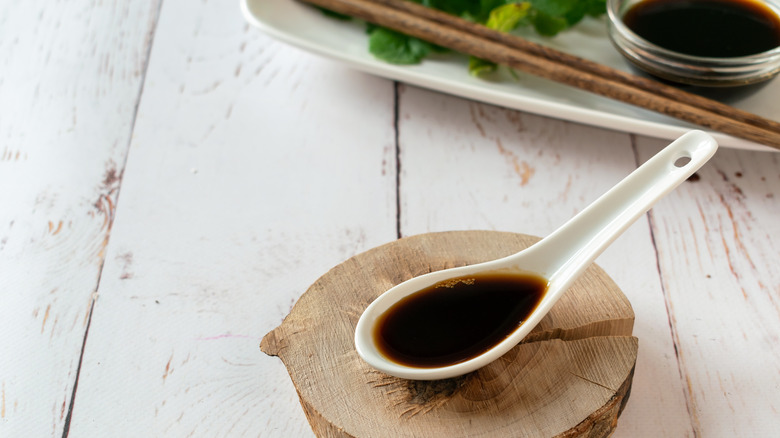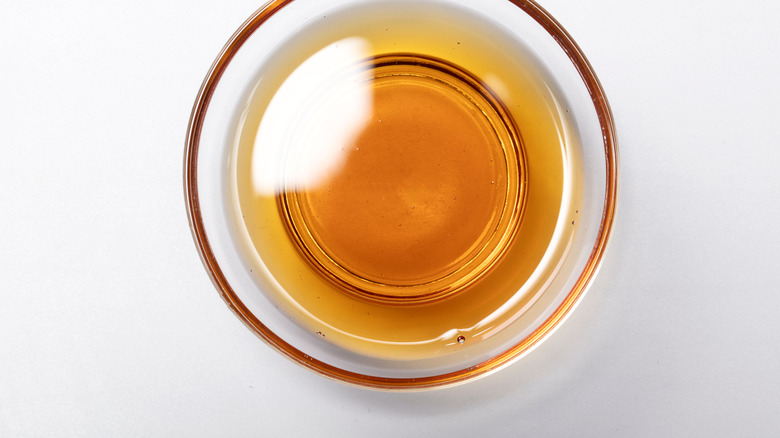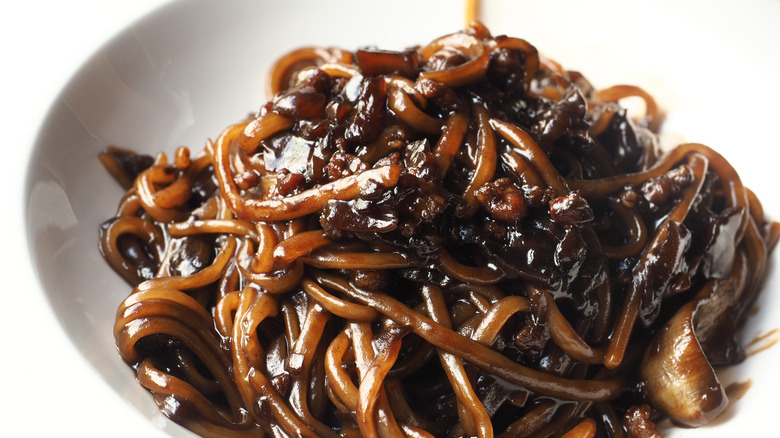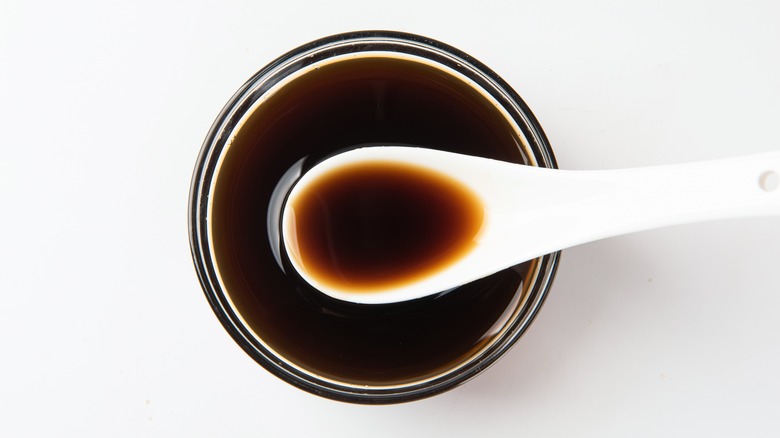25 Ingredients To Add To Your Stir-Fry Sauce
Stir fry is one of those easy weeknight meals often made to use up whatever leftover vegetables, proteins, and ingredients you have in your fridge. You can also integrate filling carbohydrates like rice or noodles into your stir fry to help bolster the dish and make it into a complete meal. But surely, there's no stir fry without the perfect stir fry sauce. The easy way out when it comes to stir-fry sauces is to purchase pre-packaged sauces from the international aisle of the grocery store. But if you read the ingredient label, you'll find that these sauces can be high in added sugar and sodium, as well as lackluster in flavor. Instead, you can assemble some of your favorite ingredients and flavors from your pantry and spice cabinet to craft the perfect, unique blend of flavors for your stir fry.
While the sheer number of options for flavoring your stir fry may appear intimidating, you should try to start with three or four at a time to ensure your flavors mesh well together — then you can start to expand your pantry and include more ingredients. After all, there's no harm in keeping things simple.
Gochujang
If you love spice, you'll love gochujang, a Korean chili paste. It's made with a blend of hot red chilis and fermented soybean paste. You can purchase gochujang in both a thick paste form as well as a thinner sauce in a squeeze bottle.
Gochujang can provide a lot of heat in a stir-fry sauce, but it can also provide an undertone of saltiness since it's made with soybeans. The heat of this ingredient can quickly overwhelm a stir-fry sauce, so it's important to add the paste gradually to avoid making your stir-fry sauce too spicy — if there is such a thing.
Miso paste
Miso paste is the salty spread you didn't know you needed. Miso is comprised of a few main ingredients including cooked soybeans, salt, and a mold culture called koji. There are three types of miso — all of which you can include in your stir fry recipe. White miso, or Shiro, is made with barley koji and white rice. Its flavor is somewhat sweet and contains the least amount of salt of the miso types. Red miso, which is made with rice, soybeans, or barley, is much darker in color and has a fuller, saltier flavor. Yellow miso has some sweet undertones but more obvious acidic tones.
Since miso is a paste, it can be used to thicken your stir-fry sauce. If you want a thinner sauce, you can dissolve the miso in a neutral oil before adding it to the rest of the ingredients.
Almond butter or peanut butter
Peanut butter and almond butter are very viscous and fatty ingredients in stir-fry sauce. You'll want to add a spoonful of your favorite creamy nut butter to help balance some of the saltiness and heat from your other stir-fry ingredients. You can make a spicy peanut sauce, which is perfect for crunchy vegetables like snap peas and cabbage, by thinning out the sauce with water and adding aromatics like ginger, garlic, and chili sauce.
Hoisin sauce
Hoisin sauce is itself a stir-fry sauce, but it can also be used to round out the sweetness and tanginess of a homemade sauce. It is made from a mixture of fermented soybeans, garlic, sesame oil, vinegar, and a hint of chili, as well as a very obvious sweet punch from the addition of sugar or honey. Hoisin sauce is often referred to as "Chinese barbecue sauce" or "Peking duck sauce" for its common pairing with meats and proteins. The sauce is very viscous and thick, which makes it an ideal component for bulking up the stickiness of a stir-fry sauce. It can also be used to add sweetness to the stir-fry sauce without requiring additional sugar.
Oyster sauce
Oyster sauce is a shellfish-based sauce made by boiling down oysters, MSG, and sugar until a thick, caramel-like consistency forms. A single teaspoon of oyster sauce can provide a unique umami richness to your stir fry sauce, marinade, or rice dish. For folks adhering to vegetarian diets, you can also purchase vegetarian oyster sauce made with mushrooms. Oyster sauce pairs well with bright flavors like citrus, as well as nutty flavors like soybean oil.
Fish sauce
Fish sauce is another ingredient that amps up the savory and umami flavor of a stir-fry sauce. This sauce is made by pressing fish like sardines, anchovies, and shrimp with salt for long periods. The fermentation of the liquid helps concentrate the salty and savory notes in the sauce. Fish sauce is significantly thinner than oyster sauce and lacks the same sweetness. Therefore, fish sauce is a great choice for a stir-fry ingredient because it amplifies the organic flavors of the veggies without making the dish overly sweet.
MSG
Monosodium glutamate, otherwise known as MSG, is both misunderstood and greatly underused in American cooking. MSG can be found in some packaged foods, but it is often relished in Asian recipes — including stir fry. The white, salt-like powder is made with glutamic acid bacteria stabilized with water and salt until the particles become crystallized. MSG acts as a flavoring agent rather than as the "salty" ingredient that many folks classify it as. MSG contains less sodium than salt, so it can be a way to curb the saltiness of your dish without slacking on flavor. There is also very little research indicating that dietary MSG has negative health implications (via the Food and Drug Administration).
The one thing you need to know about MSG is that it is very potent; you'll only need to use half a teaspoon of the crystals to flavor a family-sized portion of stir-fry sauce.
Sesame oil
Sesame oil is a pleasant, nutty, and aromatic oil used to flavor dishes. Untoasted sesame oil has a high smoke point at around 410 degrees F and presents with a neutral, and occasionally nutty flavor. You can use untoasted sesame oil (instead of vegetable or canola oil) to stir-fry your vegetables and proteins. Toasted sesame oil should be reserved for low-heat cooking and flavoring because it smokes at a low temperature. Moreover, the flavor of toasted sesame oil is much more intense and can easily be recognized by its dark amber color.
Liquid smoke
Liquid smoke may not be a stir-fry sauce ingredient you're familiar with. It's made by capturing and condensing the vapor from wood burning. The liquid itself is thin and has a complex aromatic profile — which can only be equated to sitting by a bonfire on a warm summer night.
Liquid smoke is often used in grilling recipes, but it can have an application in your stir-fry sauce too. You can easily add a couple of drops to your sauce to accentuate the flavor of proteins like beef and chicken. Like other sauce ingredients, too much liquid smoke can be off-putting, so be sure to add a couple of drops at a time and taste as you go.
Lime juice
You should never underestimate the power of fresh acid in your stir-fry sauce. Our go-to citrus for stir fry is lime juice. The lime has an organic undertone paired with a distinct tartness; it will help balance out the sweetness and saltiness of your other ingredients with ease. We recommend pairing lime with honey, peanut butter, and soy sauce for a fresh satay-style chicken stir fry. You can also add a bit of lime juice and zest to a side of white rice to insert more citrus flavor into your dish.
Rice wine vinegar
Rice wine vinegar can also be labeled as wine vinegar. This traditional Asian vinegar has made its way into a stir fry, dressing, and marinade because of its mild flavor. Most kinds of vinegar contain 6 to 7% acid, but rice wine vinegar is capped at around 4%. This means that rice wine vinegar can provide a more nuanced tartness. You can supplement the mildness of the rice wine vinegar with more organic flavor from lime juice or flavorful black vinegar.
Peanut oil
Peanut oil is a versatile oil used for dishes around the world. Refined peanut oil has a very nuanced taste and a high smoke point, making it a suitable oil to stir fry with. Green peanut oil, on the other hand, has a more waxy flavor because the peanuts are pressed raw to make the oil. Green peanut oil is the equivalent of extra virgin olive oil in cooking.
Green peanut oil has a very bright flavor that pairs well with other nutty ingredients like peanut butter and sesame oil. If you want to use green peanut oil in your stir-fry sauce, you should try to refrain from heating it to too high a temperature. Although the smoke point of this oil is around 400 degrees F, heating it can cause the flavor to lose its aromatic and flavor-forward qualities.
Mirin
Mirin has been rooted in Asia for hundreds of years. Historically, the ingredient was drunk as a healthy, sweet beverage in China and Japan. Now, people use fermented rice wine to add flavor to marinades and stir-fry sauces. Mirin is made with steamed mochi rice, fermented rice with koji, and sweet potato alcohol called shochu. The mirin's sweet notes emerge as the liquid ferments for up to a few years. Sake, which is often confused with mirin, undergoes a distillation process similar to beer and results in higher alcohol content. If you want to add a bit of sweetness to your dish and balance out other flavors, you should add a couple of tablespoons of mirin to your stir-fry sauce.
Soy sauce
Soy sauce is an umbrella of different flavors. There are several different types of soy sauce including the common Japanese soy sauce, called shoyu, which contains wheat and is often sold under the brand name "Kikkoman." Japanese soy sauce is the perfect, dark salty flavor for stir fry, but should be used in balance with other sweet, tart, and umami ingredients. You can also purchase sweet soy sauce, which includes the addition of molasses or brown sugar for a sweeter flavor. White soy sauce (or "Shiro") is a more niche type of soy sauce with a more prevalent wheat flavor. You can use white soy sauce to allow aromatics like garlic and ginger to shine through.
Cornstarch
Cornstarch is an important ingredient in a stir fry — not because it provides any flavor, but because it acts as a good thickener if you end up using too many thin sauces. On a molecular level, the starch absorbs the water and causes the sauce to become more viscous when heat is applied. If you want to add cornstarch to your stir-fry sauce, you'll first need to make a slurry by combining cornstarch and water using a 1-to-2 ratio. If you don't have cornstarch handy, you can use substitutes like all-purpose flour, arrowroot starch, or xanthan gum.
Minced garlic
Minced garlic is a very punchy ingredient that is often cooked down with the rest of the stir-fry ingredients. But mincing your garlic super finely and leaving it uncooked can add an unexpected bit of heat to your stir-fry sauce. Fresh garlic pairs well with whatever stir-fried vegetables you have left in your fridge — our personal favorites are carrots, green onions, and mushrooms.
If you don't have a garlic press handy, you can mince the cloves down by pressing them with a fork until the pieces are finely broken down enough.
Brown sugar
If you read the label of a lot of pre-packaged stir fry sauces, you'll often find dark brown sugar or light brown sugar listed. Dark brown sugar is made with a higher molasses content, so it has more caramel flavor notes. We prefer to add a bit of brown sugar to our stir fry sauce because it has the complexity that light brown sugar, or plain white sugar, lacks. You'll want to make sure to mix your brown sugar well — no one likes crunchy clumps on their snap peas.
Honey or maple syrup
If you don't want to worry about mixing your brown sugar into oblivion, you can use honey or maple syrup instead. Honey has complex organic compounds that alter the flavor of the stir fry beyond just sweetening it. It also has a low moisture, viscous texture that allows it to absorb more of the flavors of the proteins as they cook. Maple syrup has oaky undertones that pair well with soy sauce and a hint of liquid smoke.
Red pepper flakes
Crushed red pepper flakes are a hot element that can make your stir fry more whole and complex. Rather than using the whole flakes, you should sift the container of red pepper flakes over a sieve to infuse the fine dust of the flakes into your sauce. You can also pulse the red pepper flakes in a spice grinder so that the heat will be more evenly dispersed in your dish — just make sure to wash it out before you grind your next batch of spices.
Broth
Broth should be used as the base of your stir-fry sauce. But it's not the same as stock, because broth is made by quickly simmering animal bones or vegetables with water to pull out a bit of their flavor. Stock, meanwhile, takes significantly more time and develops a thicker mouthfeel because of the collagen extracted from the animal bones. While you can use stock in a stir-fry sauce, broth has a more nuanced flavor that won't overshadow the saltiness, sweetness, or tartness of the rest of your ingredients.
Tamari
Tamari is a type of soy sauce that differs from traditional Japanese soy sauce in one important way — it's gluten-free. Since tamari is made with all soybeans, it has a much more concentrated umami flavor than soy sauce. Tamari is an excellent ingredient to pair with bland foods like soybeans and rice, as well as a lower-sodium and gluten-free alternative for stir-fry sauce. From a flavor perspective, tamari has a darker flavor that provides an extra layer of complexity to the sauce.
Liquid aminos
Liquid aminos are a staple in the vegan kitchen. It's also gluten-free and made of only soybeans and water. As the name suggests, liquid aminos are essentially the concentrated building blocks of proteins found in soybeans. The taste is less salty than soy sauce with a nuanced undertone of sweetness, but you can still use it as a 1-to-1 substitution for soy sauce.
Coconut aminos are often lumped under the same umbrella as liquid aminos, but it's an entirely different ingredient. Coconut aminos are made with fermented coconut sap and sea salt. It has the same saltiness as liquid aminos and is also gluten-free and vegan.
Shaoxing
Shaoxing is a Chinese cooking wine made by fermenting water, wheat, and rice, its main ingredient. You can find this ingredient in the international or Asian section of your grocery store; it is clear with an amber hue and sweet aroma. Rice wine has a more nuanced flavor than Shaoxing, which is why we prefer to use Shaoxing instead. You can add a tablespoon of Shaoxing to amplify the tartness and sweetness in kung pao chicken or stick to using the cooking wine for cooking your favorite crunchy veggies.
Black bean paste
Black bean paste doesn't always have the same utility as other stir-fry sauce ingredients. You might be surprised to know that black bean paste is not made with the same black beans you'd find served as refried beans or in South American recipes — Asian black bean paste is instead made with fermented black soybeans, otherwise known as douchi. The boiled beans are inoculated with koji mold before being left to dry (via Daring Gourmet). The resulting flavor is more complex than a miso paste but especially sharp. Black bean paste is used to make black bean sauce, which is an especially delicious pairing for beef, garlic, and bell peppers.
Chinese black vinegar
Chinese black vinegar is a unique ingredient made by fermenting whole steamed grains in clay pots. The exact type of grain varies, but some of the most common ingredients include glutinous rice, millet, or sorghum. After six months, the grains become fermented and immersed in a unique flavor. During that process, the Maillard reaction is triggered and transforms the vinegar into its signature black color. There are regional variations in black vinegar based on the grains used in the recipe. Taiwanese black vinegar, for example, is made with carrots, onions, and mushrooms steeped for over a year.
Black vinegar is the perfect acidic supplement to your stir-fry sauce. Some Chinese cooks mix soy sauce and black vinegar, while others just use a couple of drops of the pungent acid in their sauce. You should use black vinegar for both tartness and umami flavor.
